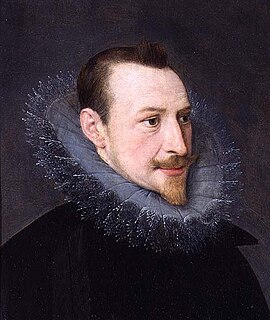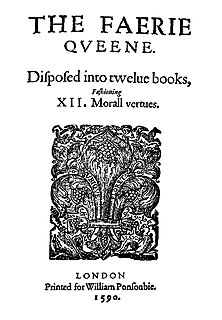
Edmund Spenser was an English poet best known for The Faerie Queene, an epic poem and fantastical allegory celebrating the Tudor dynasty and Elizabeth I. He is recognized as one of the premier craftsmen of nascent Modern English verse, and is often considered one of the greatest poets in the English language.

The Faerie Queene is an English epic poem by Edmund Spenser. Books I–III were first published in 1590, and then republished in 1596 together with books IV–VI. The Faerie Queene is notable for its form: it is one of the longest poems in the English language as well as the work in which Spenser invented the verse form known as the Spenserian stanza. On a literal level, the poem follows several knights as a means to examine different virtues, and though the text is primarily an allegorical work, it can be read on several levels of allegory, including as praise of Queen Elizabeth I. In Spenser's "Letter of the Authors", he states that the entire epic poem is "cloudily enwrapped in Allegorical devices", and the aim of publishing The Faerie Queene was to "fashion a gentleman or noble person in virtuous and gentle discipline".
The Spenserian stanza is a fixed verse form invented by Edmund Spenser for his epic poem The Faerie Queene (1590–96). Each stanza contains nine lines in total: eight lines in iambic pentameter followed by a single 'alexandrine' line in iambic hexameter. The rhyme scheme of these lines is ABABBCBCC.

"Roses Are Red" can refer to a specific poem, or a class of poems inspired by that poem. It has a Roud Folk Song Index number of 19798. It is most commonly used as a love poem.
The Fairy Queen, in English folklore, traditionally ruled the fairies.

The Shepheardes Calender was Edmund Spenser's first major poetic work, published in 1579. In emulation of Virgil's first work, the Eclogues, Spenser wrote this series of pastorals at the commencement of his career. However, Spenser's models were rather the Renaissance eclogues of Mantuanus. The title, like the entire work, is written using deliberately archaic spellings, in order to suggest a connection to medieval literature, and to Geoffrey Chaucer in particular. The poem introduces Colin Clout, a folk character originated by John Skelton, and depicts his life as a shepherd through the twelve months of the year. The Calender encompasses considerable formal innovations, anticipating the even more virtuosic Countess of Pembroke's Arcadia, the classic pastoral romance by Sir Philip Sidney, with whom Spenser was acquainted. It is also remarkable for the extensive commentary included with the work in its first publication, ascribed to an "E.K." E.K. is an intelligent, very subtle, and often deeply ironic commentator, who is sometimes assumed to be an alias of Spenser himself. The term sarcasm is first recorded in English in Spenser's poem.
Archimago is a sorcerer in The Faerie Queene by Edmund Spenser. In the narrative, he is continually engaged in deceitful magics, as when he makes a false Una to tempt the Red-Cross Knight into lust, and when this fails, conjures another image, of a squire, to deceive the knight into believing that Una was false to him.
"Prentice Alvin and the No-Good Plow" is a poem by Orson Scott Card. The poem was the basis for Card's The Tales of Alvin Maker series.
John Upton (1707–1760) was an English clergyman, academic and critic. An important early editor of Edmund Spenser, he is best known for the notes in his 1758 edition of Spenser's great romance epic The Faerie Queene, which was first published in 1590 and 1596.
Orgoglio is a literary character in Edmund Spenser's famous epic The Faerie Queene. He appears in the seventh canto of Book One as a beast and attacks the main character, Redcrosse, who symbolizes the ultimate Christian knight, during a moment of weakness. "Orgoglio" means "pride" in Italian. In chapter IX of Waverley, by Sir Walter Scott, the manor of Bradwardyne is compared to the castle of Orgoglio.
— From Sir John Harington, A New Discourse of a Stale Subject, called the Metamorphosis of Ajax

The Palace of Pleasure is a poem by James Henry Leigh Hunt published in his 1801 collection Juvenilia. Written before he was even sixteen, the work was part of a long tradition of poets imitating Spenser. The Palace of Pleasure is an allegory based on Book II of Edmund Spenser's The Faerie Queene and describes the adventure of Sir Guyon as he is taken by airy sylphs to the palace of the "Fairy Pleasure". According to Hunt the poem "endeavours to correct the vices of the age, by showing the frightful landscape that terminates the alluring path of sinful Pleasure".
Colin Clouts Come Home Againe is a pastoral poem by the English poet Edmund Spenser and published in 1595. It has been the focus of little critical attention in comparison with the poet's other works such as The Faerie Queene, yet it has been called the "greatest pastoral eclogue in the English language". In a tradition going back to Petrarch, the pastoral eclogue contains a dialogue between shepherds with a narrative or song as an inset, and which also can conceal allegories of a political or ecclesiastical nature.

The Fairy Queen or Queen of the Fairies is a figure from Irish and British folklore, believed to rule the fairies. Based on Shakespeare's influence, in English-speaking cultures she is often named Titania or Mab.

"The Mathematics of Magic" is a fantasy novella by American writers L. Sprague de Camp and Fletcher Pratt, the second story in their Harold Shea series. It was first published in the August 1940 issue of the fantasy pulp magazine Unknown. It first appeared in book form, together with the preceding novella, "The Roaring Trumpet", in the collection The Incomplete Enchanter, issued in hardcover by Henry Holt and Company in 1941, and in paperback by Pyramid Books in 1960. It has since been reprinted in various collections by numerous other publishers, including The Compleat Enchanter (1975), The Incompleat Enchanter (1979), The Complete Compleat Enchanter (1989), and The Mathematics of Magic: The Enchanter Stories of L. Sprague de Camp and Fletcher Pratt (2007). It has been translated into Dutch and Italian. In 2016, the story was shortlisted for the Retro Hugo Award for Best Novella.
Lodowick Bryskett, poet, translator, and Irish official.

Anne Paolucci (1926-2012) was an Italian-American writer, scholar, and educator. She was a research professor and chair of the English Department at St. John's University in New York, and a prolific writer who published plays, short stories, novels, poetry, literary criticism, and translations.
The House of Pride is a notable setting in Edmund Spenser's epic poem The Faerie Queene. The actions of cantos IV and V in Book I take place there, and readers have associated the structure with several allegories pertinent to the poem.
The Political and Ecclesiastical Allegory of the First Book of the Faerie Queene is a book written by Frederick Morgan Padelford to explain the allegories within the poem The Faerie Queene by Edmund Spenser. The book was first published in 1911 in Boston by Ginn and Company as part of a series of University of Washington publications. The book has been republished since and is widely cited in papers and books related to the study of Spenser and his works.







